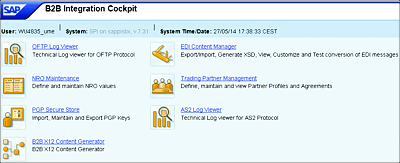5.8 Business-to-Business Integration
For any business to succeed, it needs to keep doing business with its business partners and customers. In today’s digital world, doing business involves exchanging data via interfaces or services. In some cases, these interfaces go across a company’s network boundaries. Processes such as procure-to-pay and order-to-cash between different trading partners are just two examples of B2B scenarios. In most cases, the messages to be exchanged in B2B scenarios follow some standards in terms of the protocols used and the types of messages exchanged.
In the previous release of SAP PI, there were no SAP-provided B2B capabilities. We needed to rely on third-party adapters (installed on SAP PI) to provide the needed B2B functionalities. However, SAP recently introduced Electronic Document Interchange (EDI) capabilities and technical adapters to SAP PO. In the next sections, we’ll give a high-level overview of SAP PO’s B2B integration capabilities.
5.8.1 Business-to-Business On Premise
SAP released the B2B add-on and the secure connectivity add-on (SFTP PGP) to run on SAP PO. Note that these B2B add-ons aren’t installed by default—you need to perform additional steps to make them available in your SAP PO installation. The B2B add-on includes a set of technical adapters, such as Odette FTP (OFTP), Applicability Statement 2 (AS2), and Secure FTP (SFTP), to enable exchange of EDI messages. On top of these adapters, a number of modules are also provided to facilitate the transformation of EDI formats to XML and the other way around.
To further simplify the development effort and reduce the total cost of ownership (TCO), the B2B add-on comes equipped with standard B2B mapping functions. These are EDI-specific mapping functionalities available to use in the ES Repository.
Other provided functionalities include the following:
-
Number range objects
Automatically insert sequential continuous numbers. -
Mapping templates
Predefined mappings to transform different EDI formats. -
Rapid-deployment solutions
A set of service interfaces and mappings for industry-specific processes.
5.8.2 Business-to-Business Managed Services
In addition to on-premise B2B capabilities, SAP now also provides an on-demand or cloud solution. In this approach, SAP hosts the infrastructure, integration service, monitoring, and maintenance. This model brings all the benefits of using the cloud and dramatically reduces the TCO.
5.8.3 Trading Partner Management
SAP B2B Trading Partner Management (SAP B2B TPM) is a platform to support B2B EDI by maintaining information about your trading partners in a centralized manner and by simplifying the process of communicating with your trading partners.
To access SAP B2B TPM, follow these steps:
- Make sure that your user has the SAP_PI_B2B_SUPERADMIN_J2EE role assigned.
- Launch the B2B Integration Cockpit (see Figure 5.25) by going to http://<hostname>:<port>/b2bic.
- Click on Trading Partner Management to get to the SAP B2B TPM tool.
Figure 5.25 The New B2B Integration Cockpit
There are a couple of other important SAP B2B TPM notions to grasp:
-
TPM template
Represents reusable custom forms that you can create to store data for a specific business requirement. -
TPM functional profile
Used to group different SAP B2B TPM templates to reuse them across different partners. -
Trading partner profile
A one-stop shop to access different partner information and configurations, such as partner name, partner type, classification details, and so on. Information related to partner certificates, functional profiles, agreements specified for a particular trading partner, and some EDI runtime parameters also can be accessed. -
Trading partner agreement
Define rules and conditions that are evaluated during runtime to determine which EDI parameters and functional profiles need to be used. -
UDFs
Standard functionality to retrieve the runtime values of some SAP B2B TPM parameters. Some of the provided UDFs include getParty, getAgreementID, getFunctionalProfileName, getFunctionalProfileProperty, getIdentity, getSystemEnvironment, and getPartyID. For more on each of these UDFs, please check http://help.sap.com.
We’re going to revisit the notion of adapters in the next section by touching on the often-forgotten SAP PI support for the Apache Axis framework, to further enhance the SOAP adapter. The next section will explain how the Axis framework can be leveraged and configured from the Integration Directory.
